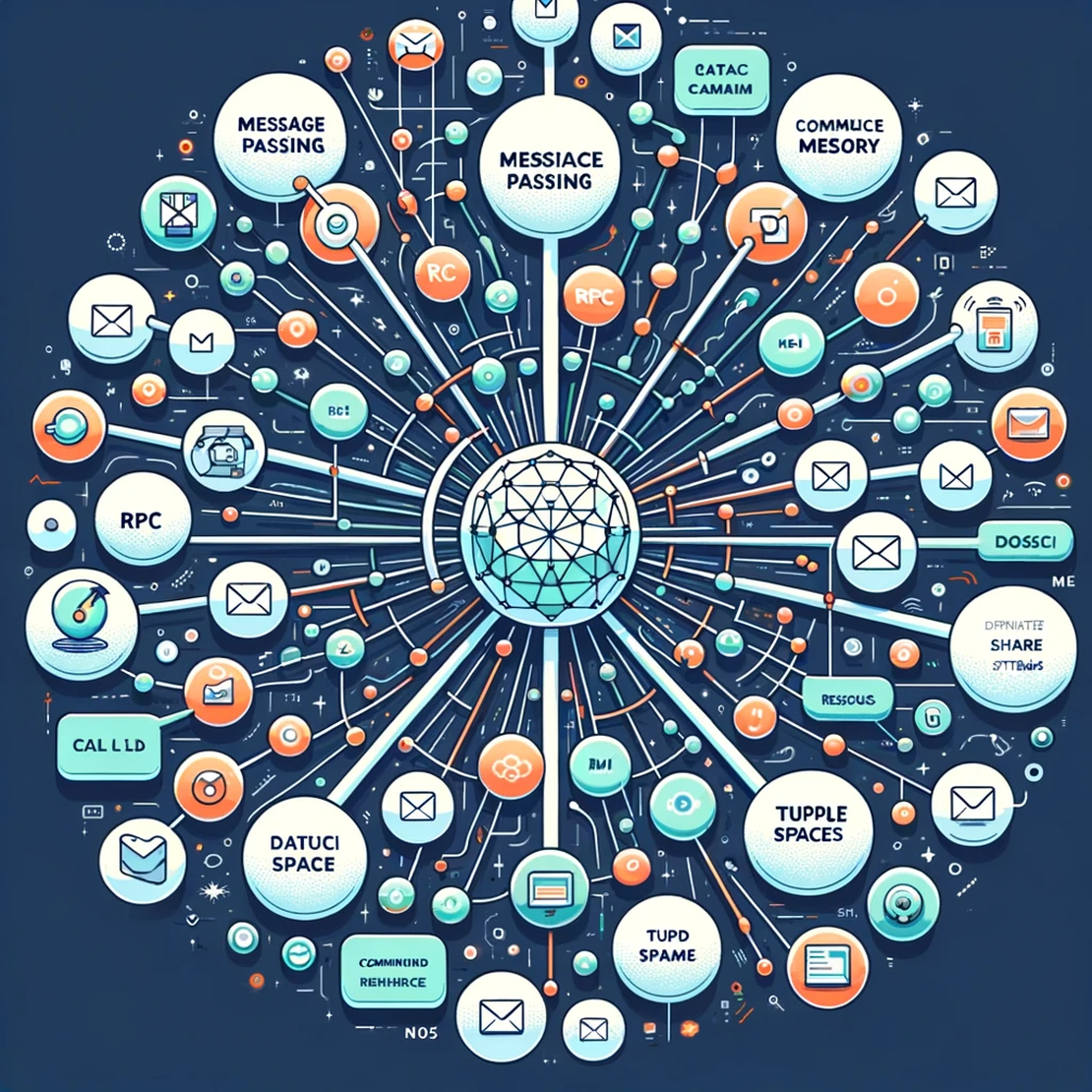
Demystifying Middleware in Distributed Systems
- Yuhang
- Internet , Cloud
- October 25, 2023
Middleware in distributed systems acts as a crucial intermediary layer, bridging the gap between network operating systems and applications.
Role and Significance
- Intermediary Layer: Middleware provides a set of services and abstractions that facilitate the development and operation of distributed applications.
- Heterogeneity Management: It aims to hide the complexity and heterogeneity of the underlying network and hardware, offering a uniform interface to application developers.
Middleware Abstractions and Paradigms
Middleware encompasses various abstractions and paradigms, each catering to different requirements of distributed systems.
Different Abstractions
- Distributed Objects and RPC: Facilitates communication between objects located in different network nodes, often using Remote Procedure Call (RPC) mechanisms.
- Message Passing and Events: Provides a framework for exchanging messages and events between distributed components.
- Shared Data Spaces and Web Services: Offers shared spaces for storing and retrieving data and web services for interoperable machine-to-machine interaction.
Paradigms in Middleware
- Distributed Object-Based Middleware: Uses object-oriented models to represent distributed components, promoting modularity and reusability.
- Message-Oriented Middleware (MOM): Focuses on message exchanges, suitable for loosely coupled systems and asynchronous communication.
- Publish/Subscribe Middleware: Supports event-driven architectures where producers publish events and consumers subscribe to them.
Distributed-Object Middleware
Distributed-object middleware provides a powerful paradigm for developing distributed applications using remote method invocation.
Remote Method Invocation (RMI)
- Advantages Over RPC: RMI extends the RPC model by supporting object-oriented programming, allowing methods to be invoked on remote objects in a way that’s natural to object-oriented developers.
- Transparency: Offers location transparency, making remote method calls as straightforward as local calls.
Natural Mapping in Distributed Systems
- Aligning with Communication Models: The distributed object paradigm aligns closely with the common model of communicating entities in distributed systems, making it intuitive for developers.
- Object-Oriented Design: Leveraging object-oriented design principles, it provides a cohesive approach to building complex distributed applications.
Challenges in Middleware Design
Designing effective middleware for distributed systems involves navigating a range of challenges to ensure scalability, performance, and adaptability.
Transparency and Scalability
- Achieving Transparency: Middleware aims to provide transparency in terms of location, failure, and replication, masking the complexity of the underlying distributed environment.
- Ensuring Scalability: Scalability is a major challenge, requiring middleware to efficiently handle an increasing number of nodes and requests without performance degradation.
Performance and Adaptation
- Optimizing Performance: Middleware must balance resource management to maximize performance, including efficient communication and data processing.
- Adapting Non-Distributed Designs: Adapting traditional, non-distributed designs to a distributed context often involves overcoming significant architectural and operational differences.
Architectural Models in Middleware
Middleware architectures vary, with different models providing specific benefits and trade-offs in the context of distributed systems.
Client-Proxy Relationship
- Role of Proxies: Proxies in middleware act as local representatives for remote objects, managing communication and translating requests and responses.
- Benefits: This model simplifies client-side development and can provide additional layers of control and security.
Runtime Systems and Server-Side Implementations
- Runtime System Responsibilities: Middleware runtime systems handle numerous tasks, including communication, object lifecycle management, and resource allocation.
- Server-Side Skeletons: On the server side, skeletons abstract the complexity of handling incoming requests, allowing developers to focus on application logic.
Object Model in Middleware
The object model in middleware defines how objects are represented, referenced, and interacted with in distributed-object systems.
Class and Object Distinctions
- Classes vs. Objects: Middleware often differentiates between classes (templates defining behavior) and objects (instances of these classes).
- Interface Definitions: Object interfaces define the methods that can be invoked remotely, providing a contract between clients and servers.
Object References and Method Invocations
- Handling Object References: Middleware manages object references, enabling clients to locate and interact with remote objects.
- Method Invocation Styles: It supports different styles of method invocations, such as synchronous, asynchronous, or one-way invocations, catering to various application needs.
Passive and Transient Objects
- Passive Objects: Typically, do not initiate communication and respond only to incoming requests.
- Transient Objects: May exist only for the duration of a specific task or session, emphasizing the dynamic nature of distributed environments.
Client and Server-Side Operations
Understanding the operations on both the client and server sides is essential for effectively utilizing middleware in distributed systems.
Client-Side Operations
- Binding to Objects: Clients must bind to remote objects before invoking methods, which involves locating and establishing a connection to the server hosting the object.
- Proxy Generation: Middleware often generates client-side proxies that act as local representatives of remote objects, handling communication and method invocation.
- Runtime System Functionalities: The client-side runtime system in middleware handles tasks such as communication, proxy management, and response handling.
Server-Side Tasks
- Hosting Object Implementations: The server hosts the actual implementations of distributed objects, processing incoming method invocations.
- Handling Invocations: Servers manage request dispatching, method execution, and sending responses back to clients.
- Object Creation and Lifecycle Management: Middleware on the server side manages the creation, activation, deactivation, and destruction of objects.
Naming and Binding in Middleware
Naming and binding are critical processes in middleware, allowing clients to locate and interact with remote objects.
Implementing Object References
- Local vs. Remote References: Middleware distinguishes between local and remote object references, handling each type accordingly for efficient operation.
- Reference Management: It manages object references, ensuring that they are accurate and up-to-date, facilitating reliable communication between distributed components.
Binding Process
- Binding Mechanism: The process of binding involves resolving object references to actual network addresses where the objects reside.
- Role of Naming Services: Naming services in middleware play a crucial role in resolving object references, translating human-readable names to system-level addresses or identifiers.
Remote Method Invocation and Its Abstractions
Remote method invocation (RMI) is a key abstraction in distributed-object middleware, enabling clients to invoke methods on remote objects as if they were local.
Standard Approach to RMI
- Invocation Semantics: RMI typically involves synchronous calls where the client waits for the server’s response, although asynchronous models are also supported.
- Handling Failures: Middleware must handle various failure scenarios in RMI, such as network failures, server crashes, or unavailability.
Communication and Event Subscription Challenges
- Implementing Efficient Communication: Ensuring efficient and reliable communication between clients and servers is a major challenge in RMI.
- Matching Event Subscriptions: In event-driven models, middleware handles the subscription and notification of events, matching publishers and subscribers effectively.
- Providing Fault Tolerance: Middleware aims to provide fault tolerance in RMI, ensuring that system functions remain operational even in the face of failures.
Middleware Services and Examples
Middleware systems offer a range of services to support distributed applications, with several examples illustrating different approaches to middleware design.
Overview of Middleware Services
- Naming Services: Provide mechanisms for naming and locating objects in a distributed environment.
- Concurrency Control: Manage the concurrent access of objects to ensure data integrity and consistency.
- Event Notification: Facilitate the subscription and notification of events in an event-driven architecture.
- Resource Management: Handle the allocation and management of system resources.
- Transaction Management: Support for transaction processing, ensuring atomicity, consistency, isolation, and durability (ACID) of transactions.
- Security Services: Include authentication, authorization, and encryption to ensure secure communications.
Examples of Middleware Systems
- CORBA (Common Object Request Broker Architecture): A standard defined by the Object Management Group (OMG) for distributed-object systems, offering a broad range of services and language independence.
- Com/Dcom (Component Object Model/Distributed Component Object Model): Microsoft’s framework for component-based software engineering, enabling inter-process communication.
- Java RMI (Remote Method Invocation): A Java API that allows objects to invoke methods on objects located remotely, providing a straightforward approach to distributed computing in the Java environment.
Conclusion
Middleware plays a crucial role in the infrastructure of distributed systems, enabling seamless interaction and integration across diverse and distributed components.
The Vital Role of Middleware
- Enabling Distributed Computing: Middleware is essential for the development and operation of distributed applications, offering a layer of abstraction that simplifies the complexity of distributed environments.
- Facilitating System Integration: It allows different components and applications to communicate and work together, regardless of their underlying technologies and platforms.
Future Trends and Challenges
- Adapting to New Technologies: As distributed systems continue to evolve, middleware must adapt to emerging technologies and changing requirements.
- Continuous Innovation: The field of middleware is marked by ongoing innovation, seeking to improve performance, scalability, and ease of use in increasingly complex distributed systems.


